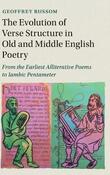Sökning: onr:20840058 > The evolution of ve...
- 1 av 1
- Föregående post
- Nästa post
- Till träfflistan
The evolution of verse structure in Old and Middle English poetry : from the earliest alliterative poems to iambic pentameter / Geoffrey Russom.
- Russom, Geoffrey (författare)
- ISBN 9781107148338
- Publicerad: Cambridge, United Kingdom ; Cambridge University Press, 2017
- Copyright: ©2017
- Engelska xi, 319 pages
- Serie: Cambridge studies in medieval literature ; 98
- Bok
Innehållsförteckning
Sammanfattning
Ämnesord
Inställningar
Hjälp
Stäng
- General principles of poetic form -- Indo-European and Germanic meters -- Old English meter in the era of Beowulf -- From late Old English meter to Middle English meter -- Middle English type A1 and the hypermetrical b-verse -- Type A1 in the a-verse -- Types B and C -- Survival and extinction in types A2, Da, and E -- Type Db and the hypermetrical a-verse -- The birth of English iambic meter -- General summary.
- "In this fascinating study, Geoffrey Russom traces the evolution of the major English poetic traditions by reference to the evolution of the English language, and considers how verse forms are born, how they evolve, and why they die. Using a general theory of poetic form employing universal principles rooted in the human language faculty, Russom argues that certain kinds of poetry tend to arise spontaneously in languages with identifiable characteristics. Language changes may require modification of metrical rules and may eventually lead to extinction of a meter. Russom's theory is applied to explain the development of English meters from the earliest alliterative poems in Old and Middle English and the transition to iambic meter in the Modern English period. This thorough yet accessible study provides detailed analyses of form in key poems, including Beowulf and Sir Gawain and the Green Knight, and a glossary of technical terms"--
- "Given the structure of English, a sound echo involving stressed syllables will usually have semantic as well as phonological prominence. Ideally, semantic relations marked by the echo will take on special meaning within a particular work. Shakespeare's rhymes highlight semantic kinships in day / May (times associated with youth), shines / declines (high point and descent), dimmed / untrimmed (loss of beauty), and fade / shade (loss of color). At a more abstract level, these rhymes align life and death with light and darkness. Alliteration has comparable semantic importance in Meredith's poem. In the fourth stanza, for example, the unifying sound echoes occur in fish, fur, fierce, fire, faggots, and froze"--
Ämnesord
- Metrik (sao)
- Medelengelsk litteratur (sao)
- Engelsk poesi (sao)
- English poetry -- Old English, ca. 450-1100 -- History and criticism. (LCSH)
- English poetry -- Middle English, 1100-1500 -- History and criticism. (LCSH)
- English language -- Versification. (LCSH)
- Poetics -- History. (LCSH)
- English language -- History. (LCSH)
- LITERARY CRITICISM / European / English, Irish, Scottish, Welsh. (bisacsh)
- English language. (fast)
- Poetics. (fast)
- Fornengelsk poesi -- historia (sao)
- English language -- Versification. (fast)
- English poetry -- Middle English. (fast)
- English poetry -- Old English. (fast)
- Versification (LCSH)
- 450-1500 (fast)
Genre
- Criticism, interpretation, etc. (fast)
- History. (fast)
Klassifikation
- PR508.V45 (LCC)
- 821.009 (DDC)
Titeln finns på 2 bibliotek.
Bibliotek i Stockholmsregionen (1)
Ange som favorit- Kungliga biblioteket (S)Ange som favorit
- Låna/reservera
-
- Placering: 2017 1961
Bibliotek i västra Sverige (1)
Ange som favorit- Göteborgs universitetsbibliotek Humanistiska biblioteket (G)Ange som favorit
- Titeln i bibliotekets lokala katalogFind@GU
-
- Placering: 810 17/238
- 1 av 1
- Föregående post
- Nästa post
- Till träfflistan
Sök vidare
Hjälp
- Fler titlar av
- Russom, Geoffrey
- Fler titlar om
- 450-1500
- Metrik
- Medelengelsk littera ...
- Engelsk poesi
-
- Fornengelsk poesi
- Fornengelsk poesi
- och historia
-
- English poetry
- English poetry
- och History and criticis ...
- och Old English ca. 450 ...
- visa fler...
- Versification
- visa färre...
- Fler titlar i denna genre
- Criticism, interpret ...
- History.
- Serie
- Fler delar
Sök utanför LIBRIS
Hjälp
- Sök vidare i:
- Google Book Search
- Google Scholar
- LibraryThing
Kungliga biblioteket hanterar dina personuppgifter i enlighet med EU:s dataskyddsförordning (2018), GDPR. Läs mer om hur det funkar här.
Så här hanterar KB dina uppgifter vid användning av denna tjänst.
Copyright © LIBRIS - Nationella bibliotekssystem

